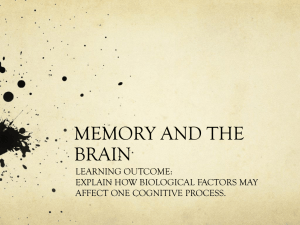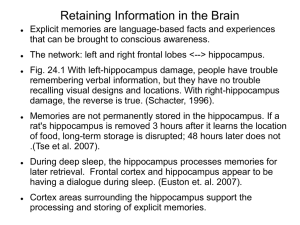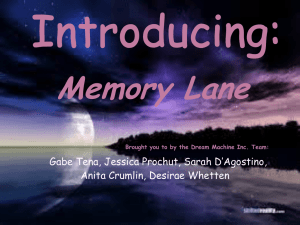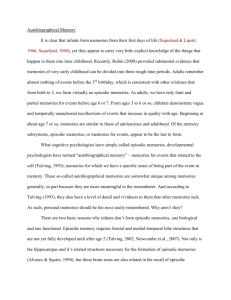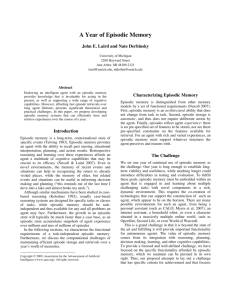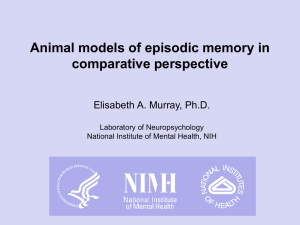Memory Consol..
advertisement
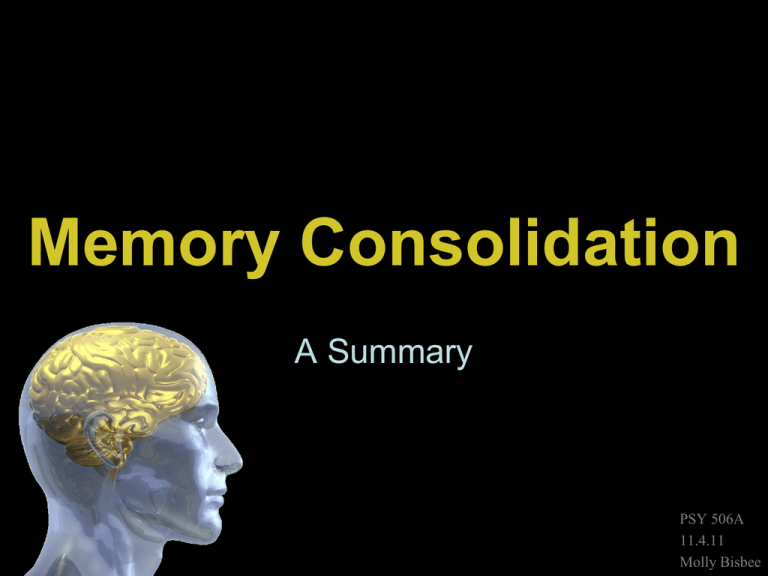
Memory Consolidation A Summary PSY 506A 11.4.11 Molly Bisbee Overview • • • • • Definition Standard model MTT Differences Evidence General Definition • A process after initial encoding that is critical to stable long-term memory – Stabilizes memories – Incorporates new information with old Temporal Characteristics • Cellular or synaptic consolidation – Brief process lasting seconds or minutes • Initial emphasis • Systems consolidation – Lasts weeks, months, or years • Recent emphasis Human Memory Systems The Standard Model (STM) • dispersed neocortical sites linked together by hippocampal complex, where ensemble trace is rapidly created (via LTP or the like) – H-trace, or “index”, “binds” the dispersed C-traces, allowing dispersed cortical sites to be reactivated together • over time, C-traces link directly; intervention of H-trace no longer needed, it fades away – information content is the same whether or not Htrace is involved in retrieval – Hippocampus plays same role in episodic and semantic memory STM STM Problems • Length of consolidation period • Dissociations among episodic and semantic memory • Reconsolidation Multiple Trace Theory • • • • H always involved in storage and retrieval of episodic memory The H-C combination is the episode memory trace H represents contextual component of episode each re-activation/retrieval of a memory occurs in different context and results in altered trace; expanded or strengthened H trace and H-C links • episodic and semantic memory must be considered separately MTT Similar to Standard Theory • hippocampus automatically encodes all attended information • H- traces are sparsely encoded in distributed representations • these ensembles act as pointers to the cortical ensembles storing attended information Different from Standard Theory • the H-C complex is the episode memory trace; H serves not only to bind elements in C, but also as the repository of critical episodic components • each re-activation of a memory occurs in a different context and results in a new sparse, distributed trace in H • each such trace shares some of the C representations MTT asserts that H and C are both always involved in the storage and retrieval of episodic memory, and that episodic and semantic memory must be considered separately. MTT Implications • Aging episodic memories either forgotten or benefit from formation of stronger, expanded, memory traces • HC active during retrieval of episode memories of any age • HC preferentially active in processing spatial/contextual material • H plays different role in episodic and semantic memory • Partial HC damage affects memories proportional to age/strength; complete HC lesions will yield flat gradient of RA for episodic, but not semantic memories • Remote memories in amnesics should be generic in nature • Older memories will have stronger, more distributed, traces in H • Reactivating a memory should lead to updating and reconsolidation HC active during retrieval of recent episode memories HC active during retrieval of episode memories of any age vs. The evidence? Left Hippocampus Standardized signal 8 6 4 Recent Remote Rest Sentences 2 0 -2 -4 -6 0 2 4 6 8 Time (secs) 10 12 14 16 18 Older memories will have weaker, less distributed, (or nonexistent) traces in H vs. Older memories will have stronger, more distributed, traces in H The evidence? Remote events Foci of left hippocampal activations across subjects Recent events Older memories are represented more diffusely within hippocampus Reactivating a memory should not affect it vs. The evidence? 60 50 49.5 45.0 40 30 20 36.3 23.8 10 4.9 0 Reminder 0.5 No-Reminder Interference Control Reactivating a memory should lead to updating and reconsolidation Reactivating a memory should reduce H involvement vs. Reactivating a memory should increase H involvement The evidence? Repeated retrievals increase activation in hippocampus – equivalently for recent and remote memories Recent 2 > Recent 1, p < 0.05 L post HC R phg Remote 2 > Remote 1, p < 0.05 L post HC R phg Reactivation • Memories can be reactivated either online (during wake) or offline (during sleep)
